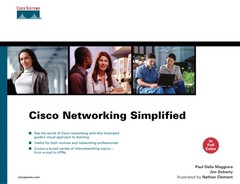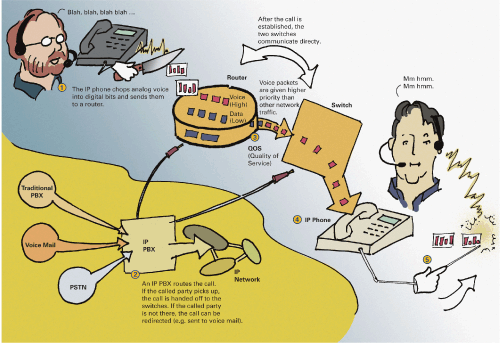Traditionally, voice traffic traveled across circuit-switched networks using private branch exchange (PBX) networks or networks of private lines and time-division multiplexers (TDMs). These traditional networks tended to be proprietary, closed systems that were expensive to maintain, upgrade, or scale.
Internet Protocol (IP) telephony integrates traditional voice services with today’s IP networks. With this convergence, both data and voice traffic traverse the same physical network, which eliminates the need for two separate networks and two separate sets of networking skills.
Migrating to an IP-based telephony network reduces the total cost of ownership for voice services in the following ways:
Toll charges—. IP telephony carries traffic through a corporation’s private IP network, thereby bypassing the dedicated, leased voice lines used to connect remote offices. Eliminating the use of dedicated leased voice lines lets a company avoid toll charges and monthly fees for these dedicated circuits and converge their voice traffic onto existing leased data lines.
Administration costs—. Because IP telephony shares the same network as data applications, you have only one network to manage. Traditionally, separate teams managed voice networks and duplicated the data network.
The convergence of voice and data networks also offers productivity not available from traditional voice networks:
Employee mobility—. Working from home or remote locations is a trend that has demonstrated increased employee productivity. Imagine conducting business over your work phone from home. With technologies such as virtual private networks (VPNs) and broadband services, employees can work from home or an airport using the tools (computers and phone) they use at work as if they were sitting at their office desks.
Application integration—. IP phones are incorporating extensible markup language (XML) browsers into their video interfaces. Therefore, a company can extend enterprise applications to employees who do not need a computer. Additionally, mobile employees can make calls across corporate phone services using their notebook computers and software-based phones. They can also retrieve their voice mail by simply downloading their e-mail.
Ultimately, it is the convergence of enterprise applications with IP telephony that will advance productivity and efficiency in ways not possible with traditional PBX networks.
An IP telephony network consists of four distinct layers:
Client layer—. Actual devices a person interacts with: IP phones, IP video-conferencing equipment, software-based phones.
Infrastructure layer—. Traditional devices associated with data networks: routers, switches, and gateways.
Call-processing layer—. Redundant call control and directories.
Application layer—. Voice mail, unified messaging (imagine receiving voice mail in your e-mail box or listening to your e-mail over the phone), personal and business productivity applications.
The client layer consists of the phones, video equipment, and software-based phones. These are the devices people interact with.
One issue implementers face when trying to convert their traditional PBX systems to IP networks is how to provide power to the phones. Traditional phones simply plug a single cable into the wall for both power and voice services. Because IP phones plug into IP networks (usually via Ethernet), traditional data networks are not able to provide power. At first glance, an IP phone must have two cables: a network cable and a power cable.
However, several alternatives allow the phone to receive power through the network cable, thereby allowing IP phones to plug and play as their traditional counterparts do:
Receive inline power from the Ethernet switch they connect to. The Cisco switches can do this.
Receive power supplied from the patch panel.
Devices at the client layer are responsible for translating the audio stream into digital data. IP phones use digital signal processing (DSP) to “sample” the audio received from the headset and convert it into digital data. This process is similar to making an MP3 copy of an audio CD.
From the perspective of delivering the reliable voice services people expect in traditional PBX networks, the infrastructure layer is most critical. It is the job of the infrastructure to ensure that a call (in the form of IP traffic) is carried from source to destination in a reliable and timely manner. Proper provisioning and network design, as well as the implementation of quality of service (QoS) mechanisms, provide the ability of a traditionally data-based infrastructure to deliver voice traffic reliably with the sound quality associated with PBX networks.
Proper implementation of QoS mechanisms in an IP network is critical to the successful implementation of IP telephony. Data networks are traditionally tolerant of delay or some degree of packet loss. However, because calls happen in real time, calls with delayed or lost packets deliver frustrating audio to the receiver in which a call either becomes choppy or becomes dropped. Implementing QoS and properly provisioning a network ensures that the data network handles calls in the manner traditionally associated with traditional telephony.
The IP PBX is the center of the call-processing layer. The IP PBX fills the role of the traditional PBX in that it provides connectivity, signaling, and device control for IP phones and gateways. Gateways allow traditional voice traffic to tunnel through an IP network. In addition, IP PBXs perform operations, administration, maintenance, and provisioning (OAM&P).
Cisco IP PBX is responsible for establishing a call between two phones, but after the call is established, IP PBX removes itself and the phones talk to each other directly. The call control (ringing the phone, directing the call, providing dial tone, etc.) is handled separately from the actual content of the call. When someone picks up the receiver, the IP PBX provides a dial tone. When someone dials a number, the IP PBX looks up the number, rings the phone on the other end, and provides the ringing sound back to the person who dialed the number. Once the person at the other end picks up the phone, the IP PBX leaves the picture because the two phones communicate directly.
Telephony gateways bridge the worlds of traditional TDM telephony networks to IP telephony networks. Gateways have several purposes:
Bridging the public switched telephone network (PSTN) to an IP network
Connecting legacy PBXs to an IP network
Tunneling legacy PBXs and phones to other legacy PBXs
IP PBX dial plans define the accessibility of all entities in a voice network. Dials plans also provide alternate path routing and policy restrictions.
An IP PBX also provides connection admission control (CAC) functionality. When a user places a call over an IP WAN, the IP PBX must determine whether enough bandwidth is available across the slower speed WAN. If the capacity exists, the IP PBX passes the call through. If not, the IP PBX then attempts to pass the call through the PSTN. The CAC and the dial plan must be tightly coupled to ensure calls are passed efficiently and appropriately through the network.
Other features also facilitate the linking of CAC and dial plans. For example, a worker in one state might dial the internal five-digit extension of a coworker in another state. If the IP WAN is filled to call capacity, the call is redirected across the PSTN. This process requires that the IP PBX append the other five digits of the phone number so the PSTN recognizes the phone number.
With the convergence of telephony and data networks, it is easy to create new applications that merge the worlds of phones, video, and computers. Examples of these applications include the following:
The ability to use speech recognition in combination with call-handling rules—Users can set up personalized rules that provide call forwarding and screening on the fly. They can forward calls to other user-defined locations such as their homes or cellular phones. Additionally, users can use voice commands to receive, reply, record, skip, and delete messages.
The merging of voice, e-mail, and fax messaging into a single “inbox”—Users can then access their voice, e-mail, and fax messages from their IP phones, cellular phones, or their PCs (via e-mail).
The mobility of a phone number—A user can log into any phone and have it assume his phone number. Thus, an employee based in Greenville, SC, can travel to the company’s Wheaton, IL, office and use the phone (with her Greenville, SC, phone number) as if she were home. This mobility presents issues that haven’t existed before, such as how to handle a 911 call. If you make a call to 911 from a phone in Illinois using a phone number that is based in Greenville, SC, how is the 911 call properly directed to the local emergency services?
Call-center processing
Integration of existing customer applications, such as (ERP), (CRM), and inventory management
IP telephony has four deployment models:
Single site—. IP telephony is implemented in a single location.
Multisite independent call processing—. IP telephony is implemented in multiple remote sites, but calls between the sites travel across the PSTN.
Multisite with distributed call processing—. IP telephony is implemented across multiple remote sites with call-processing and voice-messaging equipment present at each location. Calls travel across the IP WAN as the primary path, with the PSTN as a secondary path.
Multisite with centralized call processing—. IP telephony is implemented across multiple sites, with call processing and voice messaging centralized in a single location. This solution is often the most efficient for multisite enterprises.
The single-site and multisite with independent call-processing models are similar in that they rely primarily on the PSTN for any calls outside of a single site. These two models are often the first step when a company migrates from old-world telephony to IP-based telephony.
For multisite corporations, true independence from traditional PBX occurs when they implement either a distributed or centralized call-processing model. In both cases, the IP network is the primary path for all corporate calls, with the PSTN serving as backup when either the IP WAN is down or it has insufficient resources to handle calls.
The distributed model places call-processing and voice-messaging equipment at multiple corporate locations. The IP PBX, voice-messaging equipment, and other resources at each location act as a tightly coupled system with the other locations.
The centralized model places call-processing and voice-messaging equipment in a central location. Remote locations contain only the basic infrastructure, such as switches, routers, gateways, and endpoints such as IP phones. The centralized model is easier to administer and troubleshoot, requires less overall equipment, and provides a single-point dial plan. Implementing a robust redundant infrastructure requires the centralized model.










